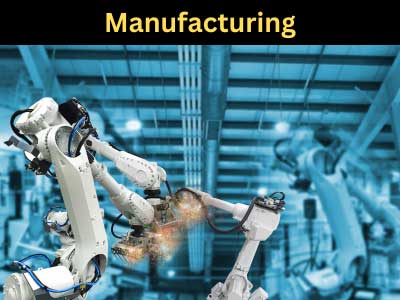Key Takeaway
The future of robotics in manufacturing is set to be transformative, driven by advancements in AI, machine learning, and deep learning technologies. These innovations will enable robots to make autonomous, data-driven decisions, self-learn from past experiences, and adapt to changing production needs. This shift will lead to more efficient, flexible, and innovative manufacturing processes.
However, challenges such as integration with existing systems and workforce adaptation must be addressed. The ongoing development of robotics promises a future where manufacturing is more automated, less dependent on human intervention, and capable of meeting the demands of a rapidly evolving market.
Current Trends in Manufacturing Robotics
Robotics in manufacturing has advanced significantly in recent years, with automation becoming a critical component of modern production lines. The introduction of collaborative robots (or cobots) and AI-driven systems has revolutionized how industries operate, enabling higher precision, faster output, and more reliable processes. Automation has extended beyond basic tasks like assembly and welding to complex operations such as quality control, packaging, and logistics.
Today’s manufacturing robots are more intelligent, adaptable, and user-friendly than ever before. They integrate seamlessly into production lines, often working alongside human workers, which enhances productivity without requiring massive infrastructure changes. As we move toward Industry 4.0, robotics are becoming more essential in smart factories, where interconnected devices and data-driven decision-making define efficiency and growth.

Collaborative Robots and Human-Robot Interaction
Collaborative robots (cobots) are reshaping the manufacturing landscape by allowing humans and machines to work side by side. Unlike traditional industrial robots, which are often isolated due to safety concerns, cobots are designed to safely interact with human workers. Cobots are equipped with advanced sensors and AI algorithms that detect human presence and respond appropriately, reducing the risk of accidents.
These robots excel in repetitive tasks like material handling, assembly, and testing, while human workers focus on more complex, creative, or decision-based tasks. This combination boosts productivity while maintaining a safe working environment. Additionally, cobots are easy to program and reprogram, allowing manufacturers to adapt them for different tasks as needed, further enhancing their utility in flexible and adaptive manufacturing environments.
Robotics in Flexible and Adaptive Manufacturing
One of the most promising advancements in robotics is their application in flexible and adaptive manufacturing. Traditional robots were limited to highly repetitive, single-task processes, but the latest generation of robots can adapt to changes in production lines with ease. This is particularly important in industries with high product variability, such as automotive, electronics, and consumer goods, where customization and shorter product lifecycles are common.
Adaptive manufacturing systems use robotics to quickly switch between tasks, making it easier for manufacturers to meet changing consumer demands. With the integration of real-time data analytics, robots can adjust their operations based on production requirements, ensuring efficiency and reducing downtime. This flexibility allows manufacturers to stay competitive in fast-paced markets while maintaining high levels of product quality.
AI-Driven Robotics in Manufacturing
Artificial intelligence (AI) is becoming a cornerstone in the evolution of robotics in manufacturing. AI-powered robots are capable of learning from their environment, identifying patterns, and making autonomous decisions. These capabilities enhance their ability to perform complex tasks, such as predictive maintenance, defect detection, and process optimization.
AI-driven robots analyze vast amounts of data generated by sensors, machines, and processes to predict equipment failures before they happen, allowing manufacturers to perform maintenance proactively and reduce unplanned downtime. Furthermore, these robots can continuously monitor product quality, identify defects in real-time, and automatically adjust manufacturing parameters to optimize output. AI is pushing the boundaries of what’s possible in manufacturing, making robots smarter, more efficient, and more responsive to real-time changes on the factory floor.
Predictions for Robotics in the Next Decade
Looking ahead, the role of robotics in manufacturing is expected to grow exponentially. In the next decade, we will likely see the widespread adoption of fully autonomous manufacturing systems where robots manage every aspect of production with minimal human intervention. AI and machine learning will enable robots to self-improve, adapt to new challenges, and perform increasingly sophisticated tasks.
The rise of 5G and edge computing will enhance communication between robots and other machines, enabling real-time data exchange and seamless coordination across production lines. This will lead to more agile and scalable manufacturing operations. Moreover, advancements in robotics will lower costs, making these technologies accessible even to small and medium-sized businesses. The integration of robotics with technologies like 3D printing and augmented reality will further revolutionize manufacturing processes, driving innovation and growth.
Conclusion
Robotics is at the forefront of manufacturing’s transformation, driving efficiency, flexibility, and innovation. From collaborative robots working alongside humans to AI-powered systems optimizing every aspect of production, the future of manufacturing is undeniably robotic. Businesses that embrace these technologies will benefit from reduced costs, increased productivity, and the ability to meet rapidly changing market demands. As we move deeper into the era of smart factories and Industry 4.0, robotics will continue to play a critical role in shaping the future of manufacturing.
